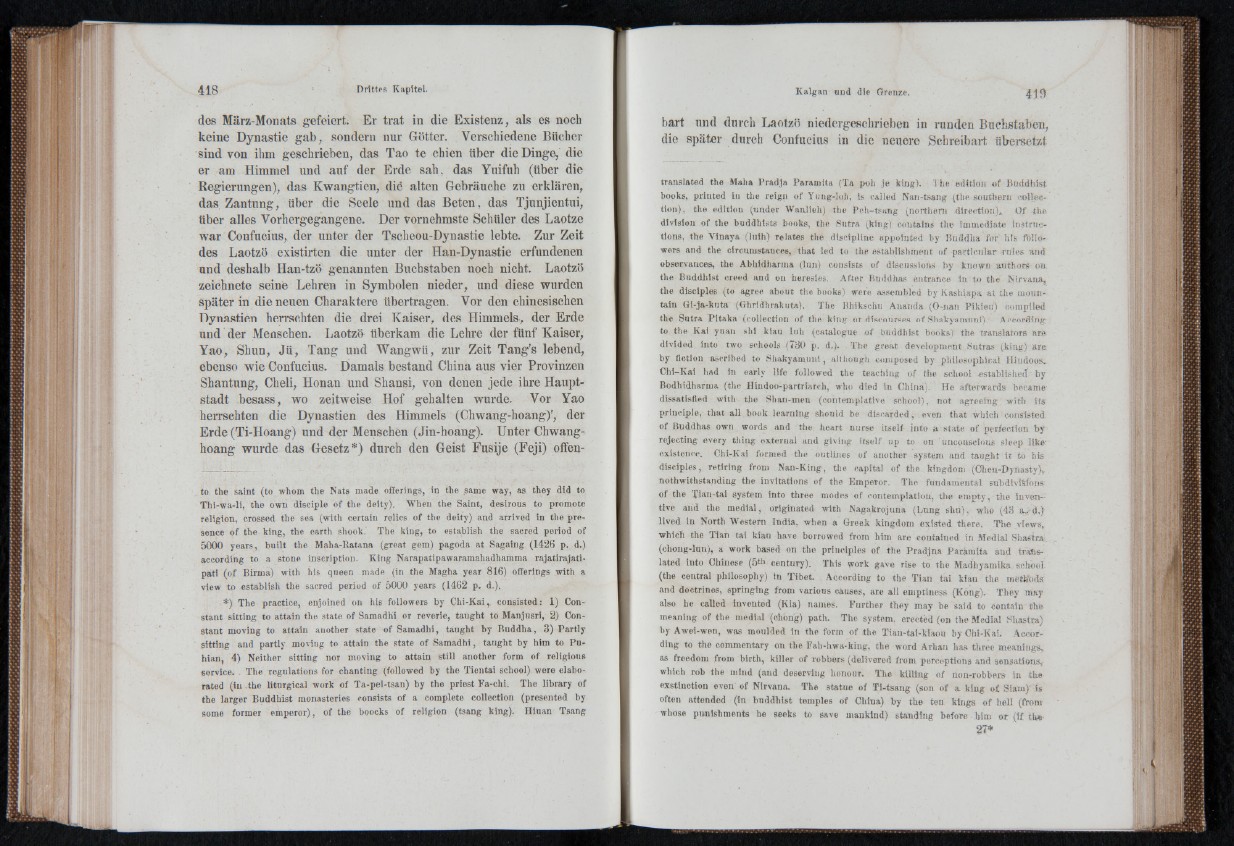
des März-Monats gefeiert. Er trat in die Existenz, als es noch
keine Dynastie gab, sondern nur Götter. Verschiedene Bücher
sind von ihm geschrieben, das Tao te chien über die Dinge, die
er am Himmel und auf der Erde sah, das Yuifuh (über die
Regierungen), das Kwangtien, diö alten Gebräuche zu erklären,
das Zantung, über die Seele und das Beten, das Tjunjientui,
über alles Vorhergegangene. Der vornehmste Schüler des Laotze
war Confucius, der unter der Tscheou-Dynastie lebte. Zur Zeit
des Laotzö existirten die unter der Han-Dynastie erfundenen
und deshalb Han-tzö genannten Buchstaben noch nicht. Laotzö
zeichnete seine Lehren in Symbolen nieder, und diese wurden
später in die neuen Charaktere übertragen. Vor den chinesischen
Dynastien herrschten die drei Kaiser, des Himmels, der Erde
und der Menschen. Laotzö tiberkam die Lehre der fünf Kaiser,
Yao, Shun, Jü , Tang und Wangwü, zur Zeit Tang’s lebend,
ebenso wie Confucius. Damals bestand China aus vier Provinzen
Shantung, Cheli, Honan und Shansi, von denen jede ihre Hauptstadt
besass, wo zeitweise Hof gehalten wurde. Vor Yao
herrschten die Dynastien des Himmels (Chwang-hoang)', der
Erde (Ti-Hoang) und der Menschen (Jin-hoang). Unter Chwang-
hoang wurde das Gesetz*) durch den Geist Fusije (Feji) offento
the saint (to whom the Nats made offerings, in the same way, as they did to
Thi-wa-li, the own disciple of the deity). When the Saint, desirous to promote
religion, crossed the sea (with certain relics of the deity) and arrived in the presence
of the king, the earth shook.' The king, to establish the sacred period of
5000 years, built the Maha-Ratana (great gem) pagoda at Sagaing (1426 p. d.)
according to a stone inscription. King Narapatipawaramahadhamma rajatirajati-
pati (of Birma) with his queen made (in the Magha year 816) offerings with a
view to establish the sacred period of 5000 years (1462 p. d.).
*) The practice, enjoined on his followers by Chi-Kai,, consisted: 1) Constant
sitting to attain the state of Samadhi or reverie, taught to Manjnsri, 2) Constant
moving to attain auother state of Samadhi, taught by Buddha, 3) Partly
sitting and partly moving to attain the state of Samadhi, taught by him to Pu-
hian, 4) Neither sitting nor moving to attain still another form of religious
se rv ice .. The regulations for chanting (followed by the Tientai school) were elaborated
(in the liturgical work of Ta-pei-tsan) by the priest Fa-chi. The library of
the larger Buddhist monasteries consists of a complete collection (presented by
some former emperor), of the boocks of religion (tsang king). Hiuan Tsang
bart und durcb Laotzb niedergeschrieben in runden Buchstaben,
die spâter durch Confucius in die neuere Schreibart tibersetzt
translated the Mali a Pradja Paramita (Ta p-oh je king). The edition of Buddhist
books, printed in the reign of Yung-Job, is called Nan-tsang (the southern collection),
the edition (under Wanlîeh) the Peh-tsang (northern direction)* 0 / the
division of the buddhists books, the Sutra (king) contains the Immediate instructions,
the Vinaya (luih) relates the discipline, appointed by Buddha for' his fôlTo-r-
wers and the circumstances, that led to the establishment of particular rules and
observances, the Abhidh&rma (Tun) consists of discussions by known authors on.
the Buddhist creed and on heresies. After Buddhas entrance in to the .Nirvana-,
the disciples (to agree about the books) were assembled by Kashiapa a t the mountain
Gi-Ja-kuta (Ghridhrakuta). The Bhikschu Aiianda (O-nau Pildeu) compiled
the Sutra Pitaka (collection of the king or discourses of .Shaky a muni).' According
to the Kai yuan shi kiau luh (catalogue of buddhist books) the translators are
divided into two schools (780 p. d,). The great development Sutras (king) are
by fiction ascribed to Shaky am u n î, although composed by philosophical Hindoos..
Chi-Kai had In early life followed the teaching of the school established by
Bodhidharma (the Hlndoo-partriareh, who died In China). He afterwards became
dissatisfied with the Shan-men (contemplative school), not agreeing with its
principle, that all book learning should be discarded, even that which consisted
of Buddhas own words and the heart nurse itself into ¡a state of perfection by
rejecting every thing external and giving itself up to on unconscious sleep like:
existence. Chi-Kai formed the outlines of another system and taught it to his
disciples, retiring from Nan-King, the capital of the kingdom (Chen-Dynasty)v
no tw ithstanding the invitations of the Emperor. The fundamental subdivisions
of the Tian-tai system into three modes of contemplation, the empty, the inventive
and the medial, originated with Nagakrojuna (Lung shu), who (43 a,-d.)
lived in North Western India, when a Greek kingdom existed there. The views,
which the Tian tai kiau have borrowed from him are contained in Medial Shastra
(chong-lun), a work based on the principles of the Pradjna Paramita and translated
into Chinese (5th century). This work gave rise to the Madhyamika school
(the central philosophy) in Tibet. According to the Tian tai kiau the mCfcbfods'
and doctrines, springing from varions causes, are all emptiness (Kong).- They may
also he called invented (Kia) names. Further they may he said to contain the
meaning of the medial (chong) path. The system, erected (on the Medial Shastra)
by Awei-wen, was moulded in the form of the Tian-tal-kiaou by Chi-Kai. According
to the commentary on the Fah-hwa-king, the word Arhan has three meanings*
as freedom from birth, killer of robbers (delivered from perceptions and sensations,-
which rob the mind (and deserving honour. The killing of non-robbers in the
exstinction even of Nirvana. The statue of Ti-tsang (son of a king of Siam)' is
often attended (in buddhist temples of China) by the ten kings of hell (from
whose punishments he seeks to save mankind) standing before him or (if the-
2 3 *